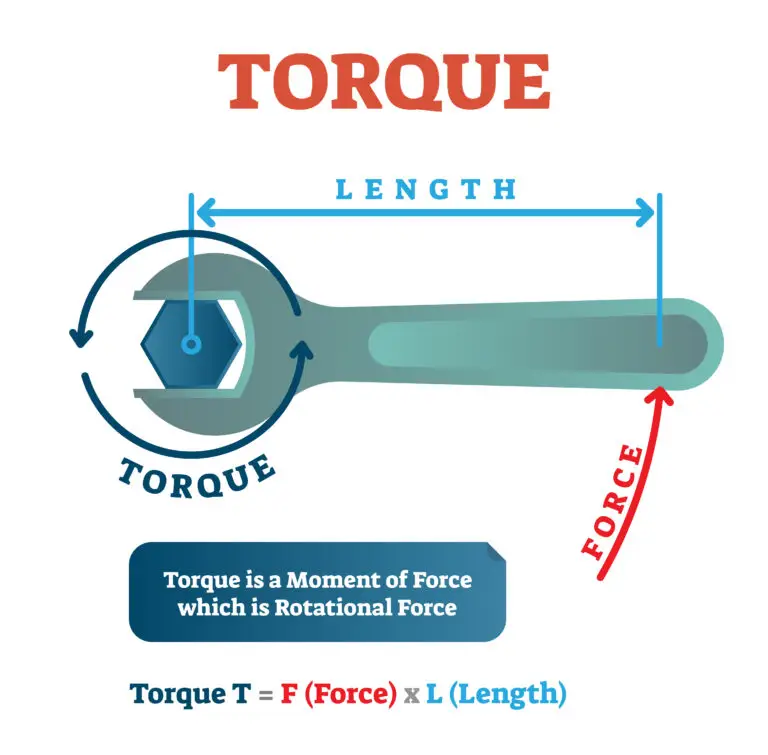Torque

Table of Contents
What is Torque?
Torque measures the rotational effect produced by a force applied to an object. It depends on the magnitude of the force, the distance from the axis of rotation to where the force is applied, and the angle of the force relative to the object.
The mathematical formula for torque (\tau) is:
\large \tau = r \times F \times \text{sin}(\theta)
where r is the lever arm, F is the force applied, and \theta is the angle between the force vector and the lever arm.
Key Aspects of Torque
Vector Quantity: Torque is a vector, which means it has both magnitude and direction. The direction of the torque vector is perpendicular to the plane formed by the radius (lever arm) and the force vector, following the right-hand rule.
Lever Arm (r): This is the distance from the axis of rotation to the point where the force is applied. The longer the lever arm, the greater the torque for a given force, making it easier to rotate the object.
Force (F): This is the push or pull applied to the object. The larger the force applied, the greater the resulting torque.
Angle (\theta): The angle between the force vector and the lever arm significantly affects the torque. Maximum torque occurs when the force is applied perpendicularly to the lever arm \theta = 90\degree, as sin 90\degree= 1. When the force is parallel to the lever arm (\theta = 0\degree \text{ or } \theta = 180\degree), the torque is zero, as sin(0\degree)=sin(180\degree)=0.
Units of Torque
The International System of Units (SI) measures torque in newton meters (N·m). This unit directly reflects the torque equation, where torque is the product of a force (measured in newtons) and a distance (measured in meters). One newton meter is defined as the torque resulting from a force of one newton applied perpendicularly to a moment arm that is one meter long.
While torque and energy can be measured in units of joules, it’s important to distinguish between them. Torque represents a rotational force, while energy denotes the capacity to perform work. The numerical equivalence between N·m and J (in terms of units) can sometimes be confusing. Still, the context in which they are used typically clarifies their meaning: joules are used for energy, work, or heat, while newton meters are specific to torque.
Direction of Torque
The direction of torque is an essential aspect of its definition as a vector quantity. Unlike scalar quantities, which have only magnitude, vectors have both magnitude and direction, which is true for torque. The direction of torque provides information about which way an object will rotate when a force is applied.
The torque’s direction is perpendicular to the plane formed by the radius (or lever arm) and the force vector. To determine this direction, the right-hand rule is commonly used:
- Point your fingers in the direction of the lever arm (r).
- Curl your fingers toward the direction the force (F) is applied.
- Your thumb, when extended, will point in the direction of the torque vector.
This means if you apply a force that would cause an object to rotate clockwise, the torque vector will point toward you. Conversely, if the force causes counterclockwise rotation, the torque vector will point away from you.
Effects of Torque
Torque is the driving force behind rotational motion, determining how and when an object will rotate around an axis. Torque is necessary to make an object start rotating. For instance, when you turn a wrench, the torque you apply causes the nut or bolt to rotate. In vehicles, the engine generates torque transferred to the wheels, making them spin and propelling the vehicle forward.
Not only can torque initiate rotation, but it can also change the rotation rate. More torque means a faster increase in rotational speed. This is crucial in machinery and vehicles, where controlling the rotation speed is necessary for proper operation.
The direction of torque determines the direction in which an object rotates. This directional control is fundamental in devices like motors and turbines, where the correct rotation direction is key to their function.
When an object is in rotational equilibrium, the total torque acting on it is zero, meaning there’s no net force causing the object to rotate. This concept is vital in engineering and architecture, ensuring that structures and mechanical systems are stable and balanced. For example, a seesaw is in rotational equilibrium when the torques produced by the weights on either side balance each other out, preventing rotation.
Related Links
Centripetal Force
Speed
Tension
Velocity